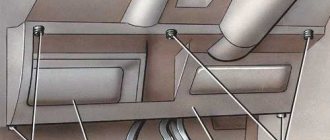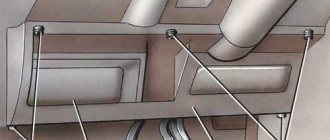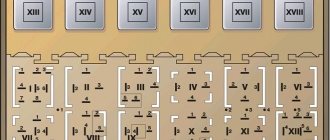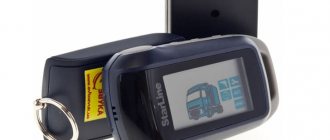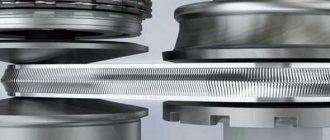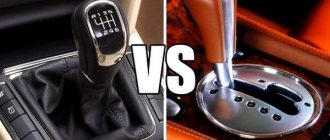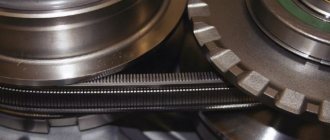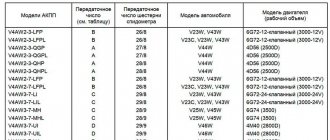Every year, the automobile market offers a huge number of models, trim levels, and modifications to suit every taste and budget of the buyer. In addition to design, comfort and engine, there is a variety of transmissions on offer. More and more manufacturers are equipping cars with both manual and automatic transmissions. But if mechanics differ mainly in the number of steps and gear ratios, then with automatics the situation is more complicated. They are presented in several types, differing from each other in operating principle, design, and scope of application.
Most often, the buyer's choice falls on 2 types of automatic transmissions - classic automatic transmission and DSG, which is also called a “robotic” transmission. Let's look at each type in more detail and try to decide which one is better.
What's bad about a robot?
The “robot” suffers greatly from slipping - it quickly overheats and breaks down. If a car with such a gearbox gets stuck in snow or mud, you should not try to get out by rocking. It is best to put the box in neutral and carefully tow the car out.
Interesting materials:
What is the difference between monologue and dialogue? What is the difference between a neurologist and a neurologist? What is the difference between forward and reverse polarity? What is the difference between pvp and pve? What is the difference between shellac and gel? What is the difference between sausages and sausages? What is the difference between Viber and Telegram? What is the difference between vintage and antique? What is Raskolnikov's worst punishment? What is the meaning of the film White Sun of the Desert?
Which gearbox is better, automatic or variator: what are the differences, which is more reliable, pros and cons
Automatic transmission and variator (sometimes abbreviated CVT) is a device for converting engine torque and transmitting it to the drive wheels. Both mechanisms perform the same function. But it should be noted: the principle of their work is similar, but has significant differences.
The automatic transmission is a little simpler. Repairs are somewhat cheaper. Before purchasing, you need to contact specialists - they will explain the differences between different boxes in simple language.
The main difference between a CVT and an automatic is that switching occurs steplessly. Regulation is carried out within a certain range specified by the designers. There are 3 main types of variators:
- chain;
- V-belt;
- toroidal.
V-belt type variator
It is the V-belt that has become most widespread for a number of different reasons. Changing the gear ratio occurs due to compression and expansion of the gear ratio. Chain type variator - is a design in the form of beveled ends of the axes of chain links. Toroidal CVTs operate using cone-shaped discs.
An automatic transmission works in a similar way. But switching is controlled by the selector. It is located on the central tunnel of the cabin or on the steering column (typical for American-made cars). By selecting a specific position of the lever (selector), it is possible to select a specific position. Often, in addition to the standard modes, there are several others.
For example, sporty and economical. The main components of a classic automatic gearbox:
- planetary mechanism (directly the gearbox itself);
- control system;
- torque converter.
The torque converter includes the following components:
- reactor;
- turbine wheel;
- pump wheel.
Torque transmission occurs due to fluid flow. It is created by the vanes of the pump and turbine wheel. The main differences between a CVT and a classic automatic gearbox:
- frequency of transmission oil changes – in CVT transmissions it is necessary to change the oil an order of magnitude more often;
- Fuel consumption on engines equipped with a CVT is an order of magnitude lower;
- the cost of repairing a variator is much more expensive.
Maintenance and repair of a variator is relatively expensive - but the unit itself is cheaper than an automatic transmission. An automatic machine is more expensive to purchase. But it can be used for a long time without repair. It is important to understand the difference between a robot and an automatic transmission - what is the difference. And based on this, make a choice in favor of a certain type of transmission.
It should be noted: CVT is only suitable for driving at relatively low speeds - 120-140 km/h. No sudden jerks or accelerations. The belt simply cannot cope with a more serious load. What is more reliable: a continuously variable transmission or an automatic transmission? The automatic transmission is definitely more reliable than a conventional CVT. That is why today automatic transmission is more common.
But we can safely say: the variator has very great potential. Developers are constantly refining the transmission design. New materials are used and the transmission mechanism is modernized. In turn, the manual transmission is gradually becoming a thing of the past. An increasing number of vehicle trim levels are equipped with automatic transmissions and CVTs. But the transition process will take many years. Visually distinguishing a CVT gearbox is not that difficult.
When choosing a car on the secondary market, you should be careful. Since often the reason for sale is the almost completely exhausted life of the transmission. To check the condition of the transmission, contact a specialized service center. This is the only way to avoid purchasing a car that requires serious repairs.
Each type of transmission has its pros and cons. The main advantages of the machine include:
- The automatic transmission puts little load on the engine and there is minimal wear;
- when replacing the entire automatic transmission, as an assembly, the costs will be minimal;
- low requirements for the quality of the oil used;
- endurance - can be used in difficult conditions.
The automatic transmission also has some serious disadvantages. First of all, the efficiency is relatively low. It is due to the presence of a torque converter - a relatively large amount of fuel is spent on rotating the blades. The main advantages of the variator include:
- more dynamic acceleration – the speed increases an order of magnitude faster than an automatic transmission;
- relatively low fuel consumption – also due to the absence of a torque converter;
- a large number of gears allows the engine to operate in a gentle mode.
There are also many quite serious disadvantages. The main, most significant ones include:
- complexity of repairs, spare parts (a metal belt will cost 30 thousand rubles or more);
- high requirements for oil;
- Long periods of operation at speeds of 140 km/h or more are not allowed.
The CVT is suitable for those who practice a relaxed driving style. Automatic – for drivers who operate their vehicle to the limits of its capabilities. It should be noted: automatic transmissions are repaired by almost all services without exception. Most models of such boxes have already been well studied. CVTs are a relatively new mechanism. Therefore, not all workshops undertake to repair it.
Which is better: DSG 6 or 7
DSG type gearbox is a robotic transmission unit. For the first time, Skoda and Volkswagen began to use this type of box in their cars en masse. We must remember: DSG and automatic are not the same thing. In this case, the driver's participation in changing gears is not required. The abbreviation DSG stands for relatively simply:
- in English - Direct Shift Gearbox;
- in German – Direktschaltgetriebe.
Main advantages and features of DSG type boxes:
- there is practically no gap between different gears;
- ease of control - no need to operate three pedals (gas, clutch, brake);
- fuel is consumed more efficiently - 10% less than when driving a manual or conventional automatic transmission.
It is worth noting: some boxes allow gear shifting not only in automatic modes. But also manually. This option is not available on all models. It should be noted that the design principle of the DSG box is almost completely consistent with the usual mechanical one. The main difference from a conventional manual transmission is the presence of two clutches at the same time. When changing gears, one of the clutches disengages. The second, on the contrary, turns on.
DSG device
It is in this way that the transmission torque is switched. Based on what was written above, it becomes clear that there are also two transmission shafts. In fact, the DSG is two boxes at once:
- for even gears;
- for odd gears.
The two boxes themselves work simultaneously. When you start moving, two gears are engaged simultaneously - first and second. But at the same time the clutch on the second one is disabled. At the moment of gear shifting, the clutch of the first gearbox is disengaged. The second clutch is turned on. All other gears are switched in a similar manner.
DSG clutch
Many owners wonder: why is a gearbox of this type called robotic - when the switching process is 100% automatic? The reason for this is the microprocessor system used to change gears. This is what distinguishes the box in question from a regular automatic machine. The gears are switched using conventional synchronizers. But the forks are driven by special hydraulic cylinders.
The clutch drive itself on the DSG is also turned on and off by hydraulic elements. A special unit – mechatronics – controls all processes occurring inside the transmission. The block includes the following main components:
- electronic;
- hydraulic;
- electrical.
The work of mechatronics consists of analyzing data from special sensors - they monitor the speed of rotation of the shafts at the input and output of the box, oil temperature and many other characteristics. The device in question is programmed. Specialist developers have written a special program for controlling electrohydraulics.
Appearance of mechatronics
Today, the automaker Skoda uses 2 different types of DSG preselective gearboxes - 6 and 7. Version 6 was released a little earlier, in 2003. But it continues to be used to this day. Version 7 - released in 2006. The first thing that distinguishes these gearboxes is the number of gears. It corresponds to the markings (6 and 7, respectively).
Another important difference between the DSG 6 (the model is marked as VW02E) is the “wet” clutch. All basket discs are constantly in a special oil bath. Moreover, such oil simultaneously solves two problems - cooling and lubrication. Which also has a positive effect on the clutch life. The box marked 6 is used on more powerful engines. She can easily “digest” a thrust of 325 Newtons. Allowed for use with 3.2 l 250 hp engines.
The DSG 7 box operates on a “dry” clutch; this model is marked as VW 0AM. Its cost is slightly less. A gearbox of this type is initially developed for low-power engines - with a torque of less than 250 hp. Moreover, this version of the box requires less oil and saves up to 10% of fuel. Often used for crossovers. It is difficult to determine which is better - wet or dry. Each box was designed to solve specific problems. Owner reviews of both types are positive.
Reviews
Konstantin, Moscow, 25 years old: Purchased a 2022 Nissan Qashqai with an automatic transmission. The impressions are positive, there are no problems. I constantly drive at speeds over 150 km/h outside the city. Many people blame the fragility of the transmission. I am completely satisfied with the purchase. Perhaps it's a matter of low mileage.
Victor, St. Petersburg, 29 years old: I bought a Nissan Teana with a CVT – 2015. After just a few thousand kilometers, a major overhaul was required. The cost of the chain was 30 thousand rubles. Work, other parts - another 35 thousand rubles. I operated the car carefully and did not drive it when it was cold. Perhaps the previous owner lied about the mileage and screwed it up. At the time of purchase, the speedometer showed only 120 thousand km.
Vitaly, Voronezh, 27 years old: Acquired a Skoda Octavia 2 with a DSG robotic gearbox in 2022. Very smooth ride, soft acceleration. I covered 100 thousand km in a year. Work on the chassis and transmission is only routine. There are no problems. Very pleased with the purchase!
When will DSG7 be discontinued?
Volkswagen doesn't talk about this. There are concerns that the box will last long enough on the assembly line, since DSG6 has been used since 2003. There are also examples of long life of frankly unsuccessful nodes. For example, the French 4-speed automatic DP0 and its numerous derivatives: DP1, DP2, AL4, which do not tolerate overheating and are distinguished by a rare “dullness” in motion. It has been used with various modifications since the early 90s, and is still installed on Renault Sandero, Duster, Nissan Almera and even on the relatively expensive Peugeot 408.
Unfortunately for motorists, now manufacturers generally care very little about the reliability of cars. The main vector of their development now is ecology. In order to save one hundred grams of gasoline per 100 kilometers, various dubious technologies are being introduced, often reducing the overall life of the car, such as direct injection, increasing turbocharging pressure or the compression ratio in the cylinders.
Gearboxes are a relatively dead-end branch of development, and DSG, paradoxically, is now at the pinnacle of progress, as it ensures efficiency (and therefore the coveted environmental friendliness). The fact that the unit “lives” on average 150 thousand kilometers is of little interest to anyone. Manufacturers are not at all interested in the existence of a secondary market - they dream of people buying only new cars and throwing old ones in the trash.
Therefore, sad as it may be, with DSG7 we have every chance of living for another 5-10 years without any major changes. And everyone will continue to pretend that this is how it should be.
Andrey Chepelev, Bibika.ru
How to determine which gearbox is installed on a car
It is relatively simple to determine how different types of gearboxes differ in appearance - the six-speed gearbox has an oblong shape. At the same time, the seven-speed gearbox is elongated vertically. It is worth noting that in the absence of experience it is difficult to visually determine the type of transmission. In addition, it is not always convenient to look under the bottom of the car.
The easiest way is to get acquainted with the information of the official dealer and send a request to the manufacturer. Another good solution is to contact a certified car service center. Pre-check will avoid problems.
How to distinguish a DSG from an automatic
The shape of the variator box and automatic transmission is significantly different:
- CVT – more compact;
- Automatic transmission is an elongated “log” shape.
Impressive dimensions are ensured by the presence of a torque converter. It is worth noting: not every driver, especially without experience, will be able to visually distinguish the design of an automatic transmission from a CVT. This is why you should:
- read the technical documentation for the vehicle;
- go through text drive.
It should be noted: when using a CVT in a transmission, it will be impossible to feel the gear shift. In turn, the automatic uses a multi-stage transmission. But the switching process is completely automatic. You can determine the type of transmission installed simply by the sound:
- The CVT emits a smooth, continuous hum during operation;
- AT – makes corresponding sounds when switching.
It should be noted: some automakers specifically install special sound sources in their CVTs. They allow you to hear switching sounds, changes in rotation speed and load. The DSG differs from the automatic one visually, in characteristics and in many other nuances. It is difficult to determine the technical condition on your own, without using special instruments. It is advisable to involve specialists in such work.
